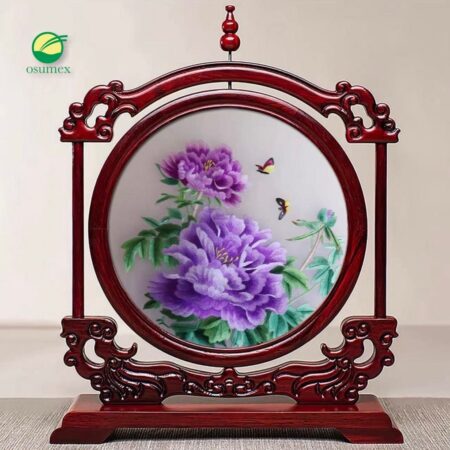Throughout history, Chinese fans have served a variety of purposes, from ritual objects to practical tools, while also standing as expressive symbols of art and culture.
These intricately crafted fans were more than simple accessories; they embodied personal aesthetic taste, social standing, and artistic values.
Over time, Chinese fans became treasured artifacts, capturing the cultural richness and social intricacies of each era.
Origins of Chinese Fans
The earliest forms of fans in China are believed to have originated from ancient people using large leaves or bird feathers to cool themselves in hot weather.
While this practical use remained central, fans also gained cultural significance over the centuries, evolving into valuable art pieces and prominent symbols of craftsmanship.
Types and Symbolism of Chinese Fans
Wuming Shan (Zhang Shan) — The Oldest Ritual Fan
The Wuming Shan, also called Zhang Shan, is a long-handled, door-shaped fan used for ceremonial purposes.
Its invention is attributed to King Shun, who ruled around 2294 BC to 2184 BC.
“Wuming” signifies enlightenment, open-mindedness, and brightness in all five cardinal directions—east, west, north, south, and center.
While the design of this fan evolved through the ages, its role as a symbol of imperial power and authority persisted until the fall of the Qing Dynasty (1636–1912).
Tuan Shan (Gong Shan) — The Artistic Moon-Shaped Fan
The Tuan Shan, or Gong Shan, is a round, moon-shaped fan that originally provided shade and protection from the elements for nobility, usually held by servants.
Over time, these fans became smaller, allowing nobles to hold them as personal accessories, decorated with elaborate artistic designs.
Calligraphy, paintings, and auspicious patterns often adorned the fans, adding to their artistic value.
Both Wuming Shan and Tuan Shan were also used to conceal one’s face.
For instance, Emperor Wang Mang (45 BC–23 AD) commanded servants to use long-handled fans as screens to hide his face, and other men employed fans to avoid eye contact in formal settings.
Women, on the other hand, used fans to cover their faces in moments of shyness or discomfort.
Wedding or Bridal Fans — The Que Shan Ceremony
In traditional Chinese weddings, the bride would carry a fan, typically the Tuan Shan, to shield her face, representing modesty, mystery, and warding off evil spirits.
After completing the wedding rituals, and once the groom had impressed the bride—often by writing a poem—the bride would finally lower her fan to reveal her face.
This important moment is known as the Rite of Que Shan, a significant part of the traditional wedding ceremony.




